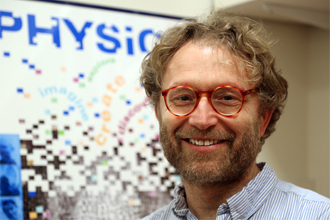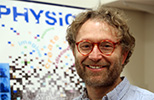INNOVATIVE TEACHING SHOWCASE
Designing Learning Experiences for the Introductory Physics Lab

At Western Washington University, the Department of Physics and Astronomy is working to engage students actively in their own learning by developing an inquiry-based lab curriculum for the introductory calculus-based physics course. The effort has drawn on a growing body of knowledge from education research about the cognitive processes in learning, as well as knowledge from physics education research about learning difficulties specific to the discipline.
We are honored and delighted to share our work in this Showcase:
- Section I describes our general approach to inquiry-based learning and teaching,
- Section II presents the specific pedagogical features of the labs, illustrated with examples
- Section III examines student response to the labs and the effects on learning.
A more detailed discussion of implementation, as well as sample lab materials and a syllabus, are included in this Showcase (see "Implementation Notes" and resources in left panel).
I. Overview of inquiry-based instruction
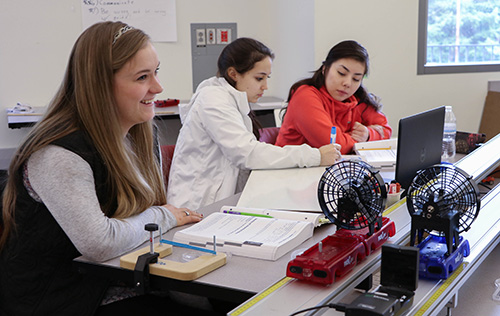

Inquiry-based instruction in physics: affordances and challenges. Physicists take pride in the aesthetic and spare logical structure of the discipline. Like chess, or algebra, a small number of starting assumptions and general laws lead to a vast array of specific results. From the perspective of an expert, very little needs to be memorized; instead, the focus is on reasoning. Physics teachers can be heard urging their students not to memorize equations, because almost everything "can be derived from first principles." The lab curriculum at Western emphasizes how we know what we know at least as much as the finalized physical concepts and laws themselves. This disciplinary focus on reasoning lends itself well to an inquiry-based approach to teaching. While factual knowledge may be successfully transmitted via passive modes of instruction, such as lecture or reading, reasoning competence comes through active exertion. As the parents of teenagers are well aware, learning the rules of the road can be accomplished through reading and memorizing, while learning how to drive can only be done by getting behind the wheel!

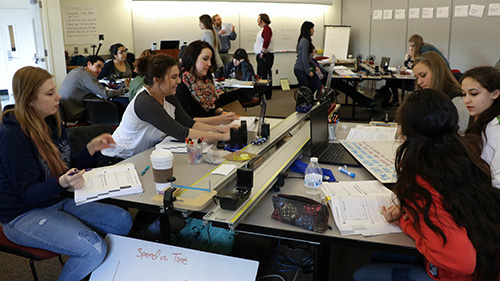
Physics education researchers have found that people's everyday ideas about the mechanical world often involve "mini-generalizations" drawn from experience (Hammer, 1996). While useful for negotiating everyday situations, these rules of thumb can obscure more universal underlying patterns. For example, imagine the child pushing the wagon with steady speed across the lawn. As soon as the child stops pushing, the wagon quickly comes to rest. From experiences such as this, the child may (consciously or otherwise) form the general rule ongoing motion requires an ongoing force. This rule makes perfect sense for explaining the motion of the wagon, and many other situations, but can seem to conflict with the formal statement of Newton's laws, which tell us that an object will continue to move in a straight-line path with constant speed all by itself, and that the role of an unbalanced force is to change the motion, rather than preserve it. (In forming the rule ongoing motion requires an ongoing force, the child is likely not considering the "invisible" opposing force of friction.) A primary role of a physics teacher, then, is to design learning experiences through which students become aware of and examine those often unconscious mini-generalizations in light of new, more systematic observations. Driven by their own curiosity and need for coherence, students can reshape their ideas about how the world works to be consistent with a broader range of phenomenon.

The role of the instructor. In this guided-inquiry approach to teaching physics, the instructor actively gauges student understanding and responds flexibly to learning needs as they arise. As she circulates around the room, a teaching assistant or faculty member might stop by a student lab group at work, listening first to assess what the students do and do not understand. She might follow with questions to draw out student thinking further, helping students to activate knowledge they can use to move forward, to bridge a gap in their reasoning, or to recognize an inconsistency between a prediction and observation. If a group is struggling, the instructor must judge whether the frustration is a manageable, productive part of the learning process, or is becoming substantial enough to interfere with the group's work. In the latter situation, which does sometimes occur, the instructor may decide to incorporate some "teaching by telling," to confirm productive parts of the group's current thinking and provide encouragement. We have found that teaching in this way requires thorough preparation. In order to respond quickly and productively, an instructor must be able to make sense of student thinking, which in turn requires a deep knowledge of the physics content itself. Each week, physics faculty and lab teaching assistants meet to go through the curriculum, discussing the ins and outs of the necessary reasoning and developing possible lines of questioning. Our undergraduate physics majors serve as TA's in the labs, and their outstanding work is essential to our program.
II. Pedagogical elements of inquiry-based physics labs at WWU
The lab curriculum employs a consistent sequence of instructional activities week-to-week. Students thus know what to expect, and can adjust their learning approaches accordingly. Table 1 summarizes the sequence.
| Activity | Purpose | Occurs |
|---|---|---|
Written Prelab |
Elicit initial ideas, engage interest |
Before students come to lab |
Guided questions and experiments |
Build conceptual understanding and lines of reasoning |
In collaborative groups during lab |
Revisit prelab |
Solidify understanding via metacognitive reflection |
In collaborative groups during lab |
Synthesis Challenge |
Activate students' learning on a challenging task with reduced scaffolding |
In collaborative groups during lab |
Written postlab questions |
Practice applying learned concepts to new situations |
As homework |
Written Synthesis Challenge mini-reports |
Solidify understanding, develop communication skills |
As homework |
Written learning reflection |
Solidify understanding via metacognitive reflection; develop independent learning skills |
As homework |
For more details on the instructional sequencing and specific learning targets, see Implementation Notes.
The prelab questions involve everyday situations and encourage students to connect the physics concepts they are learning to the real world. For example, in the prelab for static friction, students are asked to analyze the forces that act on a book when it is held against a vertical wall by a hand pushing sideways. And in the electric charge prelab, the first in the sequence for electricity and magnetism, students are asked to explain why a sock from the dryer sticks to their pant leg. After working collaboratively through the guided activities in the lab, students revisit their prelab and have an opportunity to revise their thinking and reflect on their learning.

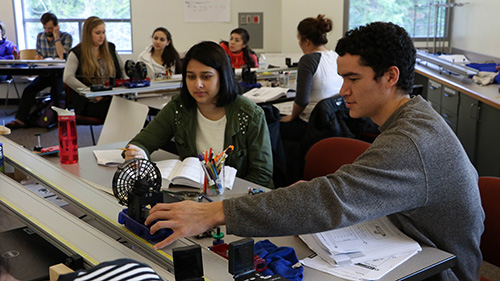
Another opportunity for students to take ownership of their new knowledge comes in the Synthesis Challenge. This culminating lab activity is more quantitative and more open-ended, involving the concepts developed in the guided inquiry portion of the lab, but with the scaffolding removed. Students must use theoretical knowledge to either build an apparatus that works correctly on the first try or to measure an unknown value. For example, in the lab on acceleration, after students are guided to interpret and coordinate graphical, algebraic, and natural language representations of motion, the synthesis challenge asks students to measure the acceleration of a rubber ball during its bounce from the floor. Students must decide what data to collect and how to collect it, as well as how to analyze that data. When students arrive at a result (typically around 10 g's), they are often surprised and delighted to find that the value is larger than large accelerations they have heard of before (i.e., that of a jet pilot or astronaut). As homework, students write a one page "mini-report" about their synthesis challenge. The main grading criterion is that the report is explicit and clear enough that another lab group could repeat the experiment and verify the conclusion.

We note that this approach to confirming student learning is consistent with the mantra "idea first, name later," advocated by Arnold Arons, an early physics education guru (Arons, 1990). Arons observed that students, and instructors, often fail to clearly distinguish the name or definition of a concept from its meaning and interpretation. (For example, simply knowing the definition a = Δv/Δt does not mean a student understands acceleration to be the change in velocity that occurs during each second of the motion.) Delaying the confirmation of ideas helps keep student attention focused on underlying meaning.
III. Evaluation
To evaluate our lab curriculum, we have measured both student learning and student attitudes. The Force Concept Inventory (FCI), a standardized test that measures conceptual understanding of Newtonian mechanics, has been given at the beginning and end of our course. Figure 2 summarizes results from 10 different introductory calculus-based mechanics courses taught at Western, involving a total of 500 students. The normalized gain < g > reports the pre- to posttest improvement as a fraction of the difference between the pretest score and 100%. Many traditionally taught physics courses have been measured nationwide, with an average normalized gain of 0.22 (Hake, 1998). We find that gains in all courses measured at WWU exceed this nationally reported average. We emphasize that these learning gains cannot be attributed solely to students' experiences in the labs, as the students completed both the lecture and lab components of the course. However, the results shown in Figure 2 involve 5 different lecture instructors, who have a variety of teaching styles and emphasize different aspects of physics understanding. Some instructors focus on conceptual understanding while others focus on quantitative problem solving; some instructors employ guided inquiry techniques while other use a more traditional lecture presentation. The uniformly strong learning gains, across all lecture sections and instructors, suggest that the labs, which all students had in common, are improving students' conceptual understanding of mechanics as measured on the FCI. We have found similar results on a standardized test of concepts in electricity and magnetism, used as a pre- and posttest for the second quarter of our introductory calculus-based physics sequence.

Figure 2. Results on Force Concept Inventory, administered before and after inquiry-based lab instruction in introductory calculus-based physics at Western Washington University.
Online surveys have been administered at the end of the course to gauge student attitudes toward the labs. These surveys ask students to agree or disagree
with a set of Likert-style statements. Of N=149 students responding on one survey, 75% either agreed or strongly agreed with the statement
Students' open-ended comments indicated a mix of positive and negative views. Many students appreciate the inquiry approach and the opportunities it provides for building their own understanding:
Common concerns were also evident. Many students expressed a desire for the lab and lecture to be more closely coordinated. Some students expressed frustration at the frequent experience of getting stuck on a challenging task or question while the lab instructor was busy helping other groups. Overall, many student comments suggest an underlying discomfort with the lack of confirmation of right answers:
We view these concerns as appropriate and understandable reactions to a learning environment that is much different from what students are accustomed to. From the student point of view, the implicit norms for how a science classroom works have suddenly changed, including a change in where the responsibility for learning rests, from the instructor to the learner. We hope in our ongoing development of the lab curriculum to improve how the instructional approach is framed for students - helping them to recognize, understand, and ultimately appreciate the shift from an instructor centered approach to one that focuses on student thinking and learning.
IV. Conclusion
At Western Washington University, students in introductory physics labs build their own understanding of key concepts through a process of inquiry. Student thinking and ideas are the focus; instructors play a supporting role, teaching by questioning rather than by telling. The lab curriculum emphasizes sense making, rather than error analysis or verification of physical law, with a goal of engaging students in the intellectual adventure of developing new knowledge of how the world works. While the learning experience is characterized by active collaboration and hands-on work, we have found that it is also important to attend carefully to the specific instructional sequence for each topic. The design of these sequences has been informed by research on student learning, and refined through cycles of testing and revision. An inquiry-based approach to physics teaching differs considerably from traditional methods, and from the initial expectations of some students, and thus does require patience to implement and tolerance for some bumps along the way. We believe that the opportunities for our students' intellectual growth are an ample and rich reward.
References
Brandsford, J.; Brown, A. and Cocking, R. (2000). How people learn: Brain, mind,
↑ Go to top


